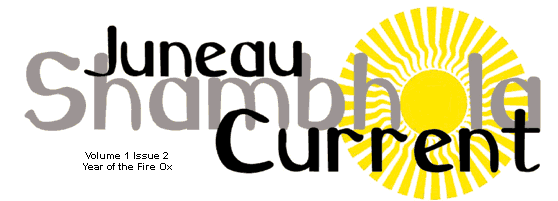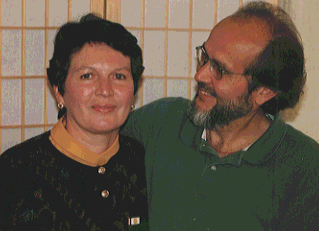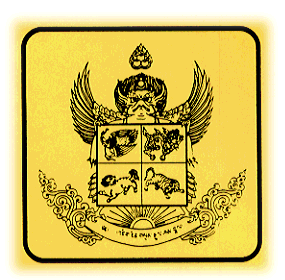
In this Fall 1997 issue:
Chapmans Depart
Shambhala Training Levels
The Psychology of Meditation
Calendar of Events
Contributions for the Current Solicited
Warm Send-Off for Chapmans
 A heartfelt farewell party was held for Susan and Jerry Chapman on Saturday August 30, 2024 at the spacious home of Shar Smith and Johnathan Wolfson in Juneau. Members of the Juneau Shambhala sangha as well as colleagues, friends and family all attended the event to wish the Chapmans well on their on their journey to Gampo Abbey.
A heartfelt farewell party was held for Susan and Jerry Chapman on Saturday August 30, 2024 at the spacious home of Shar Smith and Johnathan Wolfson in Juneau. Members of the Juneau Shambhala sangha as well as colleagues, friends and family all attended the event to wish the Chapmans well on their on their journey to Gampo Abbey.
The entire group presented two beautiful gifts to the soon-to-be-non-stop meditating couple. It was the collective wish of the group for Susan and Jerry to be continually surrounded by the warmth and spirit of the no matter where they went. Symbolically this took the shape of a cozy soft and warm camel-colored meditation shawl for Susan and a warm wool burgundy jacket for Jerry.
Thanks to everyone who helped contribute in whatever way possible to make this special event the memorable send-of that it was.
-by Julia Ross
The Psychology of Meditation
Meditation is a way of working with neurosis of ego, so in order to understand the psychology of meditation we must understand the dynamics of that neurosis. According to Buddhist psychology, the basis of ego is the tendency to solidify energy into a barrier that separates space into two entities, I and Other; the space in here and the space out there. This process is technically termed dualistic fixation. First there is the initial creation of the barrier, which is the sensing of other, and then the inference of inner or I. This is the birth of ego. We identify with what is in here and struggle to relate to what is out there. The barrier causes an imbalance between inside and outside. The struggle to redress the imbalance further solidifies the wall. The irony of the barrier creating process is that we lose track of the fact that we have created the barrier and, instead, act as if it was always there.
After the initial creation of I and Other, I feels the territory outside itself, determining if it is threatening, attractive or uninteresting. Feeling the environment is followed by impulsive action-passion, aggression, or ignoring-pulling in what is seductive, pushing away what is threatening or repelling, ignoring what is uninteresting or irritating. But feeling and impulsive action are crude ways of defending and enhancing ego. The next response is conceptual discrimination, fitting phenomena into categories, which makes the world much more manageable and intelligible.
Finally, whole fantasy worlds are created to shield and entertain ego. Emotions are the highlights of the fantasies while discursive thoughts, images and memories sustain the story line. A story of ego’s hopes and fears, victories and defeats, virtues and vices is developed. In highly neurotic people, elaborate subplots or problems then develop from the initial drama. The subplots become very complicated and compelling, often overshadowing the main drama. In psychotic people, the subplots completely overshadow the main drama. The different stages of ego development-the initial split of I and Other, feeling, impulse, conceptualization and the various fantasy worlds-are technically referred to in the Buddhist traditions the five skandhas. From moment to moment the five skandhas are recreated in such a manner that it seems the ego drama is continuous. Clinging to the apparent continuity and solidity of ego, ceaselessly trying to maintain I and Mine, is the root of neurosis. (This effort clashes with the inevitability of change, with the ever-recurring death and birth of ego, and therefore causes suffering.)
One sees the world in terms of I and the Threat, I and the Seduction; and consequently either moves out and tries to grab hold of phenomena or holds back from them, withdrawing into a defensive posture. Such clinging creates a sense of alienation which panics us into struggling to restore the balance that has been upset. Seemingly pleasurable objects become more seductive and seemingly hostile objects become more threatening. So the more one struggles either to gain pleasure or avoid pain, the more one creates dissatisfaction. One can go so far as to lose contact with the ground, which is psychosis. Or one can stabilize in a defensive way, which is what a neurotic person does.
The particular neurosis you create depends on your style of relating to the world-defensive, seductive, manipulative, encompassing or ignoring. But whatever your style, the degree to which you are neurotic depends on the extent to which you are struggling to make yourself comfortable; which is ironic, because it is the effort to make ourselves comfortable that creates the discomfort.
On the other hand, there is the possibility of breaking the chain of panic and struggle by opening to what is, by dropping the attempt continually to maintain one’s security. One can define meditation as a process of letting go, of giving up conflict, not in a passive, spineless sense, but in the sense of being present yet not manipulative. So we are faced with the moment-to-moment alternative of either opening to space, of being in harmony with it, or of solidifying and fixating it.
One must be careful not to fall into the trap of superficially letting go. What one is doing in that case is trying to compensate for the discomfort of life by smoothing it over, by trying to make oneself at ease. In the case of highly neurotic persons, their awkward attempts at easing their discomfort are obvious. But in the case of spiritual techniques such covering over is harder to detect. Rather than softening reality, meditation is a process of clearly seeing it. A good example is Don Juan’s approach to fear. He does not offer Carlos a technique to dilute fear. Instead he tells Carlos to live with fear, live with death, make death his companion, make fear his companion; but never succumb to them.
(This piece was excerpted from GARUDA, a 1976 publication put out by VAJRADHATU. The piece concludes in the next edition of the JUNEAU SHAMBHALA CURRENT.)
Shambhala Training Offered
 Warrior in the World, Shambhala Level III training will be held November 7, 8, and 9. Many people are eligible for this class and space will be limited so register as soon as possible by calling the center at 586.6987.
Warrior in the World, Shambhala Level III training will be held November 7, 8, and 9. Many people are eligible for this class and space will be limited so register as soon as possible by calling the center at 586.6987.
John Baker will be coming up from Boulder, Colorado to teach this level. He will be giving a public talk on Thursday, November 6, time and place TBA.
Contributions Solicited for Currents
Do you write? Paint or draw? Make cartoons? Take photographs? Then contact us!
The Juneau Shambhala Current is always on the lookout for interesting dharma materials for our readers. This is an excellent venue for artists and writers to show their work.
Current is published 6 times a year and the next deadline will be November 20 for the December/January issue. Send your contributions by email to:
cybrrcat@revenue.com
By mail to:
POB 35353 Juneau, AK 99803
We are looking for book/video reviews, meditation tips, personal recollections of Warrior Assembly, poems, photographs and artwork of any kind.
Help enlighten our society with your talents! KIKI SOSO!
Calendar of Events
October Happenings
- Discussion: Battle of Ego * October 1, Wednesday * 7:00 - 9:00 pm
- Program: Buddha in the Palm of Your Hand *October 10, Friday * 7:00 - 9:00 pm
- October 11, Saturday *9:00 - 12:00 & 2:00 - 5:00 pm
- October 12, Sunday * 9:00 - 12:00 & 2:00 - 5:00 pm
- Video: Creating an Enlightened Society *October 15, Wednesday * 7:00 - 9:00 pm
- Buddhist Open House * October 19, Sunday * 3:00 - 5:00 pm
- JSC Council Meeting * October 22, Wednesday * 7:00 pm
- Shambhala Study Group * October 22, Wednesday * 7:00 - 9:00 pm
- Shambhala Study Video * October 29, Wednesday * 7:00 - 9:00 pm
November Happenings
- JSC Exe. Committee Meeting * November 5, Wednesday * 5:30 - 7:00 pm
- Shambhala Study Group * November 5, Wednesday * 7:00 - 9:00 pm
- Public Talk: John Baker * November 6, Thursday * 7:30 - 9:00 pm
- Shambhala Training Level III * November 7-9, Friday 7:30 - 9:00 pm
- Saturday 8:30 - 10:00 pm * Sunday 8:30 - 7:00 pm
- Shambhala Study Group * November 12, Wednesday * 7:00 - 9:00 pm
- Sadhana of Mahamudra * November 14, Friday * Time TBA
 A heartfelt farewell party was held for Susan and Jerry Chapman on Saturday August 30, 2024 at the spacious home of Shar Smith and Johnathan Wolfson in Juneau. Members of the Juneau Shambhala sangha as well as colleagues, friends and family all attended the event to wish the Chapmans well on their on their journey to Gampo Abbey.
A heartfelt farewell party was held for Susan and Jerry Chapman on Saturday August 30, 2024 at the spacious home of Shar Smith and Johnathan Wolfson in Juneau. Members of the Juneau Shambhala sangha as well as colleagues, friends and family all attended the event to wish the Chapmans well on their on their journey to Gampo Abbey.
